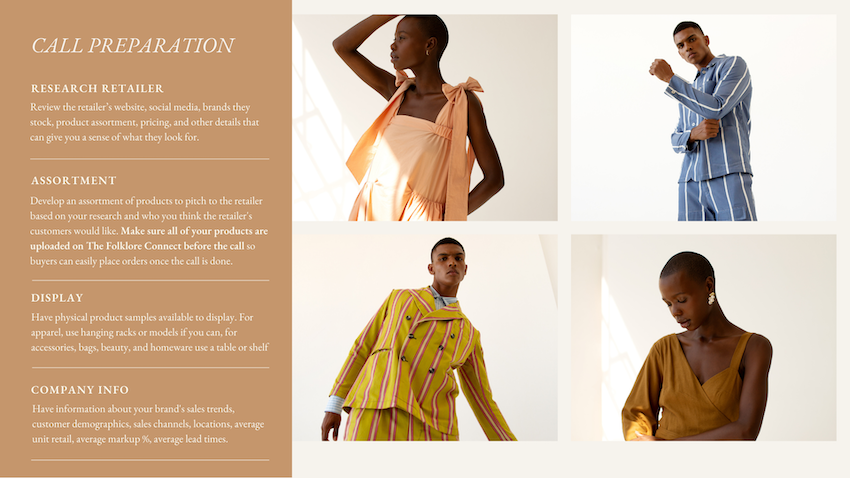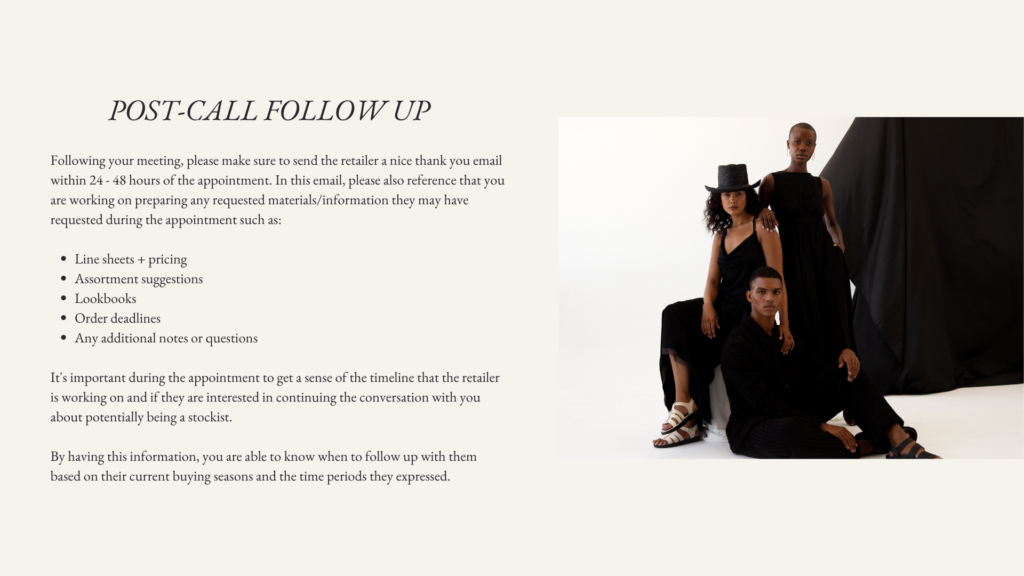The Expert Guide: Best Practices When Preparing for Virtual Buying Appointments

As the VP of Sales & Customer Success at The Folklore, Alexandra Casubolo works closely with our retail partners on their journeys with new brand suppliers. With a background in wholesale and buying at places such as Joor, she has collaborated with retailers including Shopbop, Neiman Marcus and Selfridges throughout their market process. For this edition of the Speaker Series, she is joined by Brand Account Manager, Christina Sardianos, and together, they share best practices for a successful market appointment informed by their years of experience in the industry.
From meticulous pre-appointment research to a polished and engaging presentation during the meeting, and a prompt follow-up afterward, the insights they share share serve as a comprehensive guide for brands looking to expand into retail as they embark on their wholesale journey. With these tips, brands can position themselves as reliable, collaborative partners, enhancing their chances of getting their products into the retail stores aligned with their vision.
Prepare for your virtual appointment

Know your retailer: Casubolo emphasizes the importance of thorough research on the retailer you are meeting with. “First and foremost, the most important thing to do is research the retailer,” she says. Dive into their website, analyze the current offerings, and identify trends. Note brand adjacencies, understanding where your brand fits among their collection.
“What I would do is check out their current brand and product offerings to really get a full understanding of what they have,” Casubolo advises. “As you’re doing that, determine where your brand fits among the mix and note other brands that they currently carry that you could see yourself sitting next to. Be prepared to bring up those examples when you actually meet with them.”
Come prepared: Arm yourself with crucial information — wholesale prices, retail prices, mark-up percentage, minimums for production, and lead times. “Buyers will always be noting these and asking questions throughout the appointment,” says Casubolo. “Share where you produce your goods and whether you can land them in the country that your retailer is in. If you have a D2C business or if you have existing wholesale business with other retail partners, share any bestsellers that you’d like to highlight.”
Understand the retailer’s needs: Sardianos stresses the need to make retailers feel like you’re part of their team. Check out their social media, understand their customer profile, and tailor your approach accordingly.
Before the meeting


Prepare your tech: “There are a lot of virtual appointments these days and it can be a little tricky sometimes when it comes to connecting to the Wi-Fi, or getting logged into the Zoom or Teams call, so always arrive early. Get yourself set up and make sure you’re connected,” says Casubolo. She also recommends setting up good lighting and a clutter-free background so that you are presenting yourself and your product in the most clear and visual way.
Questions and answers: Come with a set of questions to understand the retailer’s needs and be prepared to answer some yourself. Ask about order quantities, delivery windows, payment terms, and what the next steps in the process are.
“An important detail is packaging requirements”, Sardianos says. “For those bigger enterprise retailers, those requirements can be very specific, so make sure you understand that, and if your factory or manufacturer can handle those requirements. Because they can be so specific, each retailer will typically have a guide that explains it all, so ask for one.”
It’s very important to structure your meetings properly because the time is very limited. “Most of these meetings are usually around the half-hour mark, and buyers are very busy so be very conscious of time and use your 30 minutes wisely,” says Casubolo. “Always start with introductions; give a couple minutes for introductions and let them introduce themselves. Use another two to three minutes to tell your brand story, and then the bulk of your appointment – about 20 minutes – should be dedicated to presenting your collection. At the end, allow for a couple of minutes for you to ask the questions you have, and to answer some of theirs. Finish with any closing information and the next steps.”
During the meeting

Showcase your products: Now it’s time to show off your designs so make sure you tailor the presentation of your collection based on your research and the information you’ve learned about the buyer. Share your unique brand story and what makes your brand special so that you can emotionally connect with the buyer. Start with what categories you produce, who your customer is, whether you sell D2C (direct-to consumer) or if you have any existing retail partners.
“If you’re showing apparel, it’s great to have mannequins or dress forms if possible,” advises Casubolo. “It’s always helpful for the buyers to see the product on a model just to see how the fabric drapes or how it fits. In a virtual appointment, when you physically present the collection, actually hold the product up to the camera.”
During your presentation, focus on key selling points such as product functionality, customer demand and feedback. “If you have any press or celebrity traction, share that, too,” says Casubolo. Emphasize how your products are made, unique fabrications, and quality. If you have specific sourcing practices or a unique story behind your materials, share it. “As you’re going through each style, if it comes in different colours, variations of fabrics or materials, share that as well. You may not have samples of everything but you want to give the buyer the full view of options you have.”
After the meeting

Follow up promptly: Follow up within 24 to 48 hours with a quick note to express gratitude for the meeting. Reference a personal touch or something discussed during the appointment. A simple “Thank you so much for meeting with me. It was such a pleasure” will do.
Casubolo advises to also make a reference to any action items that were raised during the meeting. “You want to mention that you’re working on preparing any of the materials that they’ve asked for, which could be finalised line sheets and pricing, or assortment suggestions based on feedback that they had, or fabric swatches for exclusive pieces,” she says. “It should be a really nice, short and sweet recap so that you’re both on the same page about what you discussed.”
Building a reputation for reliability is crucial, which you can demonstrate by responding promptly to any questions, and showing your commitment to the collaboration. “That’s the number one thing we always tell our brands,” Sardianos shares. “Over communicate, be as prompt as possible with responses to any questions the buyers have.”
